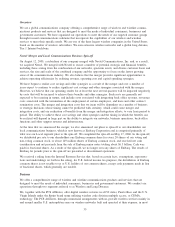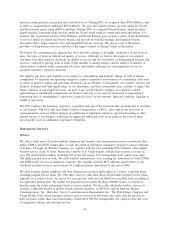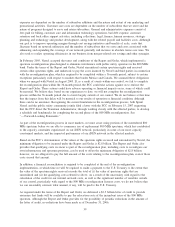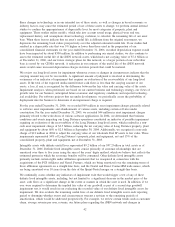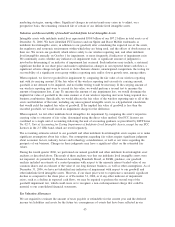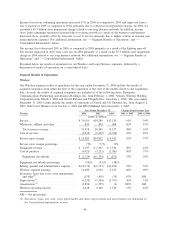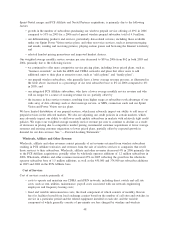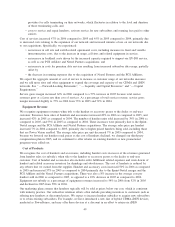Sprint - Nextel 2006 Annual Report Download - page 47
Download and view the complete annual report
Please find page 47 of the 2006 Sprint - Nextel annual report below. You can navigate through the pages in the report by either clicking on the pages listed below, or by using the keyword search tool below to find specific information within the annual report.
Presentation). EITF Issue No. 06-3 requires that companies disclose their accounting policy regarding the
gross or net presentation of certain taxes. Taxes within the scope of EITF Issue No. 06-3 are any tax assessed
by a governmental authority that is directly imposed on a revenue-producing transaction between a seller and
a customer and may include, but is not limited to, sales, use, value added and some excise taxes. EITF Issue
No. 06-3 is effective for our quarterly reporting period ending March 31, 2007. We are in the process of
evaluating the impact of this issue on our consolidated financial statements.
In June 2006, the FASB issued Interpretation No. 48, Accounting for Uncertainty in Income Taxes, or FIN 48,
an interpretation of SFAS No. 109, Accounting for Income Taxes. FIN 48 clarifies the accounting for
uncertainty in income taxes recognized in an enterprise’s financial statements in accordance with SFAS No. 109,
and prescribes a recognition threshold and measurement attribute for the financial statement recognition and
measurement of a tax position taken or expected to be taken in a tax return. FIN 48 also provides guidance on
derecognition, classification, interest and penalties, accounting in interim periods, disclosure and transition.
FIN 48 is effective for our quarterly reporting period ending March 31, 2007. The cumulative effect of
adopting FIN 48 generally will be recorded directly to retained earnings. However, to the extent the adoption
of FIN 48 results in a revaluation of uncertain tax positions acquired in purchase business combinations, the
cumulative effect will be recorded as an adjustment to any goodwill remaining from the corresponding
business combination. We do not believe the adoption of FIN 48 will have a material impact on our
consolidated financial statements.
Results of Operations
We present consolidated information as well as separate supplemental financial information for our two
reportable segments, Wireless and Long Distance. The disaggregated financial results for our two segments
have been prepared in a manner that is consistent with the basis and manner in which our executives evaluate
segment performance and make resource allocation decisions. Consequently, we define segment earnings as
operating income before depreciation, amortization, severance, lease exit costs, asset impairments and other
expenses. See note 14 of the Notes to Consolidated Financial Statements appearing at the end of this annual
report on Form 10-K for additional information on our segments. For reconciliations of segment earnings to
the closest generally accepted accounting principles measure, operating income, see tables set forth in “—
Wireless” and “— Long Distance” below. We generally account for transactions between segments based on
fully distributed costs, which we believe approximate fair value. In certain transactions, pricing is set using
market rates.
Consolidated
Our operating results for 2006 include the results of Nextel Partners from July 1 through the end of the year
and the PCS Affiliates that we acquired in 2006, either from the date of acquisition or from the start of the
month closest to the acquisition date through the end of the year. Our operating results for 2005 include the
results of Nextel from August 12 through the end of the year and the PCS Affiliates that we acquired in 2005,
from the date of acquisition through the end of the year. For further information on business combinations, see
note 3 of the Notes to the Consolidated Financial Statements appearing at the end of this annual report on
Form 10-K. These transactions affect the comparability of our reported operating results with other periods.
2006 2005 2004
Year Ended December 31,
(in millions)
Net operating revenues ......................................... $41,028 $28,789 $21,647
Income (loss) from continuing operations ........................... 995 821 (2,006)
Net income (loss) ............................................. 1,329 1,785 (1,012)
Net operating revenues increased 43% in 2006 as compared to 2005 and 33% in 2005 as compared to 2004,
reflecting growth in revenues of our Wireless segment, resulting primarily from the business combinations
discussed above, partially offset by declining revenues of our Long Distance segment. For additional
information, see “— Segment Results of Operations” below.
45


